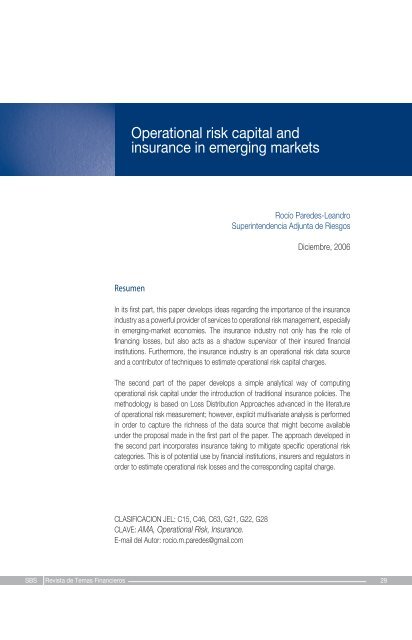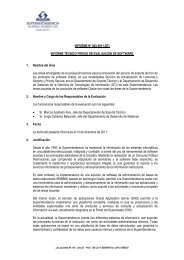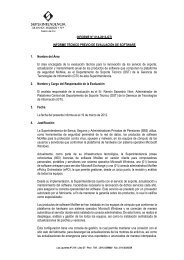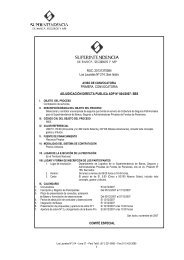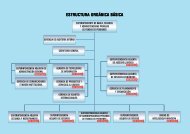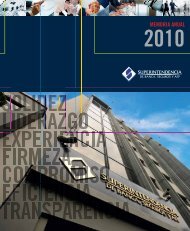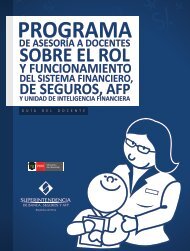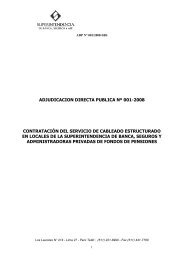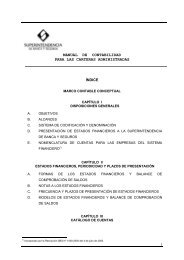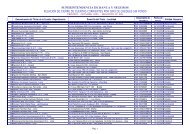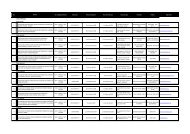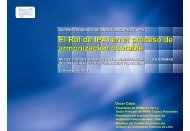Operational risk capital and insurance in emerging markets
Operational risk capital and insurance in emerging markets
Operational risk capital and insurance in emerging markets
Create successful ePaper yourself
Turn your PDF publications into a flip-book with our unique Google optimized e-Paper software.
ut only for their large f<strong>in</strong>ancial <strong>in</strong>stitution members. This dem<strong>and</strong>s regulators(particularly those with a supervisory scope <strong>in</strong> both bank<strong>in</strong>g <strong>and</strong> <strong><strong>in</strong>surance</strong> sectors)to have a lead<strong>in</strong>g role. After all, it is not enough to unconditionally take the historicaldata <strong>and</strong> forecast potential f<strong>in</strong>ancial losses <strong>and</strong> the required <strong>capital</strong> for a specificbank. It is also necessary to know the sources of those potential losses <strong>and</strong> theparticular conditions those losses occurred.Given that the implementation of Basel 2 <strong>and</strong> the use of AMA to loss model<strong>in</strong>gare planned for the com<strong>in</strong>g years even <strong>in</strong> emerg<strong>in</strong>g market economies, theirregulators should promote the use of available <strong>in</strong>formation potentially provided bythe <strong>in</strong>ternational <strong><strong>in</strong>surance</strong> <strong>in</strong>dustry through an <strong>in</strong>ternational data center or a similararrangement. By do<strong>in</strong>g this, they can generate relevant <strong>in</strong>dicators for each <strong>risk</strong>, sothat they can be <strong>in</strong>cluded <strong>in</strong> the estimation of operational <strong>risk</strong> <strong>capital</strong>. And, it wouldprovide the right <strong>in</strong>centives to f<strong>in</strong>ancial <strong>in</strong>stitutions towards improv<strong>in</strong>g operational<strong>risk</strong> management practices (measured by the generated <strong>in</strong>dicators) <strong>and</strong> to benefitfrom the implied reduction of <strong>capital</strong> charge.II.4. INSURANCE AS A PROVIDER OF METHODS FOR OPERATIONAL RISKCAPITAL ESTIMATIONMeasurement of operational <strong>risk</strong> requires to know the stylized facts of the datadescrib<strong>in</strong>g operational losses. Data gathered <strong>in</strong> a systematic way <strong>and</strong> cover<strong>in</strong>ga reasonable period of time is scant. Nevertheless, from the few data sourcescurrently available Embrechts et.al (2004) extracts some key features:• Once <strong>in</strong> a while, operational <strong>risk</strong> losses can reach extreme levels.• The frequency of operational loss events is not regular over time.• There is a seem<strong>in</strong>g source of selection bias <strong>in</strong> data collected through timebecause f<strong>in</strong>ancial <strong>in</strong>stitutions have been cluster<strong>in</strong>g more operational <strong>risk</strong> events<strong>in</strong> recent times as <strong>in</strong>ternal controls have been put gradually <strong>in</strong> practice.Hence, the construction of statistical models to measure operational <strong>risk</strong>, haveto – at least – capture those stylized facts. The aim of these models is to havereasonable quantitative approximations to the operational loss data <strong>and</strong> to usethese approximations to gather more <strong>in</strong>sight about the <strong>risk</strong>y events under study.<strong>Operational</strong> <strong>risk</strong> losses have features that are similar to loss events <strong>in</strong> the <strong><strong>in</strong>surance</strong><strong>in</strong>dustry. This is the reason why the existent operational <strong>risk</strong> models have much to<strong>in</strong>herit from actuarial sciences. Before <strong>in</strong>troduc<strong>in</strong>g these models, it is useful to br<strong>in</strong>g<strong>in</strong> formally the object under study <strong>in</strong> this paper: <strong>Operational</strong> <strong>risk</strong> losses.SBS Revista de Temas F<strong>in</strong>ancieros 34
Here, S tis the aggregated loss <strong>in</strong> each t years <strong>in</strong> the sample. Total losses aredeterm<strong>in</strong>ed by the sum of the loss events occurred <strong>in</strong> each of the R categories ofoperational <strong>risk</strong>s. The losses due to each of the <strong>risk</strong> categories i <strong>in</strong> turn is the sumof all the n t,iobserved losses <strong>in</strong> year t. Hence, the loss k <strong>in</strong> year t, for operational<strong>risk</strong> of category i is denoted by z kt,i.With equation (1) at h<strong>and</strong>, AMA can be used to determ<strong>in</strong>e probability distributionsfor total losses or by <strong>risk</strong> categories. Once the distributions are estimated, various<strong>risk</strong> metrics (<strong>and</strong> therefore <strong>capital</strong> requirements) can be calculated easily. In generalthere are three AMA approaches that can be of use with<strong>in</strong> this paper. The LossDistribution Approach (LDA), Extreme Value Theory (EVT) <strong>and</strong> Ru<strong>in</strong> processmodels. The follow<strong>in</strong>g subsections briefly expla<strong>in</strong> these approaches <strong>and</strong> extracttheir benefits <strong>in</strong> view of the ma<strong>in</strong> purpose of this paper.II.4.1 THE LOSS DISTRIBUTION APPROACH (LDA)The tasks here is to estimate parametric distribution functions for the frequency ofevents (n t,i) <strong>and</strong> for the severity of each event (z it,i) <strong>in</strong> separate ways. Afterwards,convolution operations 10 are done to derive the total loss distribution as def<strong>in</strong>ed <strong>in</strong>equation (1). This allows to calculate usual <strong>risk</strong> metrics <strong>in</strong>volved <strong>in</strong> the calculationof operational <strong>risk</strong> <strong>capital</strong>.The estimation of these parametric distributions can be performed by maximumlikelihood methods. Additionally, some of the usual distributions can be modeled<strong>in</strong> a multivariate fashion <strong>and</strong> hence provide a way to <strong>in</strong>troduce condition<strong>in</strong>g factorsfor frequency <strong>and</strong> severity models 11 .II.4.2 EXTREME VALUE THEORY (EVT)In contrast to LDA models that use all available data, EVT models only considerextreme-valued data. It is sensible to th<strong>in</strong>k that extreme losses are more relevant todeterm<strong>in</strong>e exposure to operational <strong>risk</strong>. Cruz (2002) po<strong>in</strong>ts out that the key questionis how much <strong>capital</strong> a bank needs to be protected of an eventual operationalcatastrophe. This means that for <strong>risk</strong> management purposes, the behavior <strong>in</strong> thetail of the loss distribution is of paramount <strong>in</strong>terest. This is done by EVT 12 .To apply EVT, first some metric has to be established to determ<strong>in</strong>e what an“extreme” value is. Once this value is known, the Peak over Threshold (POT)method is used to fit the EVT model for the selected data. The drawback of EVT10 This method is used <strong>in</strong> the actuarial mathematics for non-life <strong><strong>in</strong>surance</strong>.11 The second part of the paper shows how these multivariate model<strong>in</strong>g can be done.12 This methodology is used <strong>in</strong> the <strong><strong>in</strong>surance</strong> <strong>in</strong>dustry to measure catastrophic <strong>risk</strong> events.SBS Revista de Temas F<strong>in</strong>ancieros 35
models is that there are no references to estimations consider<strong>in</strong>g multivariatefactors. This turns out to be crucial for the model<strong>in</strong>g choice <strong>in</strong> the paper becausea multivariate context is preferred <strong>in</strong> order to be as close as possible to BCBSguidel<strong>in</strong>es. The statistical theory of EVT has not gone too far yet to be able tocondition the behavior of extreme-valued losses to diverse condition<strong>in</strong>g factors.II.4.3 RUIN THEORYTo ease the analysis, all <strong>risk</strong> categories can be aggregated, so equation (1) canbe re-written as:Where n(t) is the number of total losses occurr<strong>in</strong>g <strong>in</strong> period [0,t] across all<strong>risk</strong> categories 13 . Ru<strong>in</strong> theory considers the follow<strong>in</strong>g stochastic process 14 :This process is def<strong>in</strong>ed for an <strong>in</strong>itial <strong>capital</strong> amount for operational <strong>risk</strong>, k <strong>and</strong> apremium p>0. Just like <strong>in</strong> <strong><strong>in</strong>surance</strong>, the idea is the suitable choice of <strong>in</strong>itial <strong>capital</strong>to avoid ru<strong>in</strong> dur<strong>in</strong>g a given period of time. Namely, the analyst wants to know if R tcan achieve a low value (typically below zero).Hence, operational <strong>risk</strong> <strong>capital</strong> can be directly calculated if we first def<strong>in</strong>e a ru<strong>in</strong>probability (e) <strong>and</strong> an <strong>in</strong>terval of time [T1,T2]. Given process (2), the ru<strong>in</strong> (Rt
The aggregated loss S comb<strong>in</strong>es two r<strong>and</strong>om variables ( n <strong>and</strong> zi) whoseconditional distributions are previously estimated. Therefore the aggregation Sis itself a r<strong>and</strong>om variable whose distribution has to be determ<strong>in</strong>ed by convolutionmethods.The frequency of loss events ( n ) has an estimated probability distributiondenoted by pn= Pr( N = n)while the loss severity distribution ( z ) hasestimated density distribution <strong>and</strong> cumulative distribution functions denoted byf z y F z , respectively. Accord<strong>in</strong>g to Bee (2005) the cumulative probability distributionfunction of S is def<strong>in</strong>ed as:Where pn=Pr(N=n) <strong>and</strong> Pr(w£SI N = n ) is the probability tohave a cumulative loss lower than S given that n events have occurred.Due to the fact that S is the cumulative sum of loss severities, its distributionfunctions can be estimated by the convolution procedure outl<strong>in</strong>ed <strong>in</strong> AppendixA. Once this is done, expected losses as well as <strong>risk</strong> metrics can be extracted.In particular, operational <strong>risk</strong> <strong>capital</strong> is such that it covers the unexpected lossesfor the period <strong>capital</strong> reserve was made. Unexpected losses are def<strong>in</strong>ed as thedifference between a high percentile of the loss distribution (Accord<strong>in</strong>g to Basel 2,99,9-percentile) <strong>and</strong> the expected loss value.It is important to highlight that the estimation of tail percentiles is always uncerta<strong>in</strong>because it depends on the specific form of loss distribution <strong>and</strong> the type of dataunder consideration. Therefore operational <strong>capital</strong> estimation must account for thisuncerta<strong>in</strong>ty <strong>in</strong> the form of operational <strong>capital</strong> <strong>in</strong>tervals.III.1.2 OPERATIONAL RISK CAPITAL UNDER THE PRESENCE OF INSURANCEIntroduction of <strong><strong>in</strong>surance</strong> requires first the consideration of qualitative guidel<strong>in</strong>esestablished by the BCBS, as well as the <strong>in</strong>clusion of particular <strong><strong>in</strong>surance</strong> contractfeatures.Insurance contracts change the form of the orig<strong>in</strong>al loss distribution ( ) FSbecause net losses with <strong><strong>in</strong>surance</strong> are lower than those obta<strong>in</strong>ed <strong>in</strong> the absenceSBS Revista de Temas F<strong>in</strong>ancieros 38
of <strong><strong>in</strong>surance</strong>. Follow<strong>in</strong>g Insurance Companies (2001), the st<strong>and</strong>ard elements of<strong><strong>in</strong>surance</strong> can be summarized <strong>in</strong> Table 1.Table 1: Quantitative conditions of the <strong><strong>in</strong>surance</strong> contractParametersd eeD al eeL aDef<strong>in</strong>itionSpecific deductible to each loss eventAggregate deductibleLimit for each event of lossAggregate limitCR p E(0,1) Credit <strong>risk</strong> haircut of the <strong>in</strong>surer 18The <strong>in</strong>terpretation of these variables is as follows:• If a loss event of size zioccurs, the loss payment by the <strong>in</strong>surer is: z _ i d ee . Thispayment can not be higher than the limit l ee.• If there are n loss events <strong>in</strong> the <strong><strong>in</strong>surance</strong> period, the total sum of amountsthat the <strong>in</strong>surer pays must be higher than the aggregate deductible Dabutlower than the aggregate limit. La. When this occurs the <strong>in</strong>surer pays out anamount <strong>in</strong> excess of Da. Otherwise, the loss payment is equal to the maximumcoverage L .a• This means that cumulative high losses are effectively <strong>in</strong>sured while the smallcumulative losses are absorbed by the <strong>in</strong>sured bank.• The <strong><strong>in</strong>surance</strong> effect under the features of the contract outl<strong>in</strong>ed above is thenobta<strong>in</strong>ed us<strong>in</strong>g the follow<strong>in</strong>g formula:• Accord<strong>in</strong>g to these equations, cumulative losses ( S ) with <strong><strong>in</strong>surance</strong> are lowersegthan those <strong>in</strong> the absence of <strong><strong>in</strong>surance</strong> ( S ). Therefore, the loss distributionfunction shifts to the left as described <strong>in</strong> Figure 1. This <strong><strong>in</strong>surance</strong> contract allowsthe 99-percentile to reduce more than the expected loss value <strong>and</strong> so lowersoperational <strong>risk</strong> <strong>capital</strong>.18 Even though the BSCB establishes a m<strong>in</strong>imum rat<strong>in</strong>g of A for <strong><strong>in</strong>surance</strong> providers, the paper considers lower-rated <strong>in</strong>surers not reach<strong>in</strong>g vulnerable levels. Thisis because it is too str<strong>in</strong>gent to require emerg<strong>in</strong>g-market f<strong>in</strong>ancial <strong>in</strong>stitutions to operate with <strong>in</strong>surers that rank better than their own countries. For this reason, itis necessary to perform an adjustment accord<strong>in</strong>g to the pay<strong>in</strong>g ability rat<strong>in</strong>g of the <strong><strong>in</strong>surance</strong> company.SBS Revista de Temas F<strong>in</strong>ancieros 39
Figure 1: Comparison of the accumulative loss distribution withFigure 1: Comparison of the accumulative loss distribution with <strong>and</strong> without<strong>and</strong> without <strong><strong>in</strong>surance</strong>.<strong><strong>in</strong>surance</strong>.10.999%Cumulative probability0.80.70.60.50.40.30.2After InsuranceBefore Insurance<strong>Operational</strong> <strong>risk</strong> <strong>capital</strong> after <strong><strong>in</strong>surance</strong><strong>Operational</strong> <strong>risk</strong> <strong>capital</strong> before <strong><strong>in</strong>surance</strong>0.10200 400 600 800 1000 1200Total loss (In thouns<strong>and</strong>s of US Dollars)III.1.3 ADVANTAGES, DRAWBACKS AND IMPORTANCE OF THE METHODOLOGYUnlike other models, the proposed methodology considers conditional <strong>in</strong>dicatorsof severity <strong>and</strong> frequency of events to model operational <strong>risk</strong> <strong>capital</strong> <strong>and</strong> <strong>in</strong>troduces<strong><strong>in</strong>surance</strong> effects upon this <strong>capital</strong>. Thus it allows to asses the marg<strong>in</strong>al benefitsof different conditions affect<strong>in</strong>g f<strong>in</strong>ancial <strong>in</strong>stitutions as well as the environmentsurround<strong>in</strong>g the f<strong>in</strong>ancial system. On the other h<strong>and</strong>, this paper identifies the validityof <strong><strong>in</strong>surance</strong> contract schemes proposed by <strong>in</strong>surers to f<strong>in</strong>ancial <strong>in</strong>stitutions.However, the current applicability of the methodology has limitations. First, theproposed source of data collection only conta<strong>in</strong>s <strong>in</strong>formation about f<strong>in</strong>ancial<strong>in</strong>stitutions who take <strong><strong>in</strong>surance</strong> . Second, the paper does not establish thevariables to be considered for each <strong>risk</strong> <strong>in</strong> a st<strong>and</strong>ard way, this issue deservesfuture research attention. The paper only proposes that the data must be built from<strong><strong>in</strong>surance</strong> <strong>in</strong>dustry. Last, the <strong>in</strong>clusion of <strong><strong>in</strong>surance</strong> <strong>in</strong> the LDA method responds toa traditional <strong><strong>in</strong>surance</strong> scheme. Alternative <strong>risk</strong> transfers schemes dem<strong>and</strong> furtheradjustments to the methodology.The proposed methodology is important for f<strong>in</strong>ancial <strong>in</strong>stitutions, <strong>in</strong>surers <strong>and</strong>regulators alike. It allows to capture <strong>in</strong>dividual bank conditions for the estimationof operational <strong>risk</strong> <strong>capital</strong> <strong>and</strong> to know the relevant <strong>in</strong>formation useful to make<strong>in</strong>vestments decisions regard<strong>in</strong>g the improvement of factors with higher marg<strong>in</strong>alimpacts on the frequency or severity of operational losses. In the case of <strong>in</strong>surers,it provides systematic <strong>in</strong>formation for both the estimation of premiums <strong>and</strong> thedevelopment of <strong><strong>in</strong>surance</strong> schemes accord<strong>in</strong>g to <strong>in</strong>dividual bank situations. In thecase of regulators, besides dem<strong>and</strong><strong>in</strong>g them the challenge to undertake the lossdata collection proposed here, it offers them a reference to assess AMA estimationspresented by f<strong>in</strong>ancial <strong>in</strong>stitutions.SBS Revista de Temas F<strong>in</strong>ancieros 40
III. 2 AN APPLICATION TO A RETAIL BANK IN AN EMERGING-MARKET ECONOMYThe paper concentrates on a hypothetical retail bank that operates just onebus<strong>in</strong>ess l<strong>in</strong>e (retailer bank) <strong>and</strong> faces just one <strong>risk</strong> category (for <strong>in</strong>stance fraud<strong>and</strong> <strong>in</strong>ternal theft). Furthermore, the <strong><strong>in</strong>surance</strong> policy covers only that <strong>risk</strong>. Theseare simplify<strong>in</strong>g assumption to show how the methodology works. As mentionedbefore, this methodology assumes the availability of operational loss data <strong>and</strong> theconditional factors beh<strong>in</strong>d.The assumption is that the operational <strong>risk</strong> controls of this bank are below the<strong>in</strong>dustry st<strong>and</strong>ard <strong>and</strong> that conditions surround<strong>in</strong>g the bank are <strong>in</strong>deed <strong>risk</strong>y. Thisf<strong>in</strong>ancial <strong>in</strong>stitution has assumed the expected losses as part of its normal controls,hence the operational <strong>risk</strong> <strong>capital</strong> to be calculated is the difference between the99,9 percentile <strong>and</strong> the expected value of total losses. All the data employed <strong>in</strong> theanalysis here<strong>in</strong> is simulated.III.2.1 OPERATIONAL RISK CAPITAL WITHOUT INSURANCEFollow<strong>in</strong>g the previous Section, the explanatory variables of fraud <strong>and</strong> <strong>in</strong>ternal theftconsider two types of controls: Control 1 is a control quantity <strong>in</strong>dicator <strong>and</strong> Control2 is a control effectiveness <strong>in</strong>dicator. The two controls have a negative relationshipwith the probability of occurrence of loss events. Both control <strong>in</strong>dicators aremeasured by percentages between 0 <strong>and</strong> 100. Table 2 summarizes the data.Table 2: Descriptive Statistic of DataFrequency model<strong>in</strong>gIn this application, the data is fit to a conditional Poisson distribution, namely theprobability of the frequency of events is driven byWhere n represents the number of loss events due to fraud or <strong>in</strong>ternal theftobserved every year. It is important to note that the Poisson model is conditional.Namely, every n iobserved <strong>in</strong> the sample is r<strong>and</strong>omly obta<strong>in</strong>ed from a Poissondistribution with parameter λ i, which <strong>in</strong> turn, is conditioned to the two level ofcontrols X (1) <strong>and</strong> X (2) of this specific example. Accord<strong>in</strong>g to Greene (1993), licanbe modeled as In(I i ) = b'X i <strong>and</strong> the parameter ß can be obta<strong>in</strong>ed via maximumlikelihood methods. For the present exercise, the estimation isSBS Revista de Temas F<strong>in</strong>ancieros 41
The important advantage of this formulation is that it can condition the frequencydistribution to various control values. In Figure 2 for example Control 1 is set to itsmean value <strong>and</strong> Control 2 is allowed to vary between 0 <strong>and</strong> 1 (poor to best-practicelevels). The result is a jo<strong>in</strong>t probability distribution of the number of events (n) <strong>and</strong>Control 2. The lower the quality of controls, the higher is the probability of occurr<strong>in</strong>gmore than three loss events. Conversely, when controls are close to best-practice,the probabilities are highly concentrated around zero loss occurrences.Figure 2: Conditional Bivariate Distribution (Frequency <strong>and</strong> Control 2)Figure 2: Conditional conditional Bivariate Distribution on Control (Frequency 1 <strong>and</strong> Control 2)conditional on Control 10.80.70.7Jo<strong>in</strong> Probability0.60.50.40.30.20.1010.60.50.40.30.20.50.1Control 200 1 2 3 4 5 6 7 8Severity model<strong>in</strong>gHypothetical loss severity amounts were simulated together with three determ<strong>in</strong><strong>in</strong>gkey factors: net <strong>in</strong>comes, the level of complexity of bus<strong>in</strong>ess l<strong>in</strong>e operations <strong>and</strong>level of personnel experience <strong>in</strong> the management of the activity subject to <strong>risk</strong>. Net<strong>in</strong>comes (NETY) are positively correlated to the severity of events. The bus<strong>in</strong>esscomplexity level (COMPLEX) is a cont<strong>in</strong>uous <strong>in</strong>dex between 1 <strong>and</strong> 5. The higherthe bus<strong>in</strong>ess complexity is, the higher the possible severities are. The experiencelevel (EXPR) varies <strong>in</strong> the cont<strong>in</strong>uous <strong>in</strong>terval 1 to 4. The higher the experience levelis, the lower the severities are. Table 3 summarizes the simulated data.Table 3: Descriptive statistics of severity of loss <strong>and</strong> constra<strong>in</strong>t variablesSBS Revista de Temas F<strong>in</strong>ancieros 42
A straightforward way to model the severity loss distributions conditional on the<strong>risk</strong> <strong>in</strong>dicators outl<strong>in</strong>ed <strong>in</strong> this example is the multivariate Log-Normal. In thisdistribution, the logarithm of loss amounts together with suitable transformationsof key <strong>risk</strong> <strong>in</strong>dicators can be model as a multivariate normal 20 .Given the conditional nature of this procedure, effects like those presented <strong>in</strong> Figure3 can be shown. There, the distribution on the left depicts a low-<strong>risk</strong> situation(benchmark) with NETY = 1 200 US$ thous<strong>and</strong>s, COMPLEX = 2.5 <strong>and</strong> EXPR= 3.5. The one on the right corresponds to a relatively high-<strong>risk</strong> situation of thehypothetical bank under study here (NETY = 2 000 US$ thous<strong>and</strong>, COMPLEX = 4,EXPR = 2). In the low-<strong>risk</strong> situation, if there is an adverse event, the mean amountof loss is US$ 58 thous<strong>and</strong>; whereas <strong>in</strong> the high-<strong>risk</strong> case the mean <strong>in</strong>creases toUS$ 148 thous<strong>and</strong>.Figure 3: Conditional loss severity distributionsFigure 3: Conditional loss severity distributionshigh-<strong>risk</strong> factorslow-<strong>risk</strong> factors0.020.015Probability0.010.00500204060 80 100 120 140Amount of losses <strong>in</strong> thouns<strong>and</strong>s of US Dollars160180200Aggregate LossAt this stage it is important to recall the two components of the aggregate lossdistribution model<strong>in</strong>g:• The frequency of loss events is modeled via a conditional Poisson distributionWith λ conditional to two control variables: Quantity <strong>and</strong> quality of controls.• The severity of loss events is modeled via a Log-Normal multivariate model.Namely, the logarithm of loss amount x (0) = In(z) is distributed accord<strong>in</strong>g to anormal distribution conditional on <strong>risk</strong> <strong>in</strong>dicators such us net <strong>in</strong>come, bus<strong>in</strong>esscomplexity levels <strong>and</strong> personnel experience 21 .20 Of course more <strong>in</strong>terest<strong>in</strong>g multivariate distributions can be used for severity model<strong>in</strong>g. For the purposes of this paper multivariate normal are enough. To modelall the variables as normals, the orig<strong>in</strong>al data is monotonically transformed (Appendix B conta<strong>in</strong>s the details).21 See Appendix B for details of the log-multivariate model<strong>in</strong>g.SBS Revista de Temas F<strong>in</strong>ancieros 43
The convolution methodology of the conditional Poisson model for frequency <strong>and</strong>conditional log-normal for severity is based on the steps:1. Establish the numerical value (X (1) , X (2) ) to determ<strong>in</strong>e the value of the parameter λto be used <strong>in</strong> f (n; λ )2. Establish the numerical value of severity factors: net <strong>in</strong>come (NETY), complexity(COMPLEX) <strong>and</strong> experience (EXPR).3. Generate a r<strong>and</strong>om number n from the frequency distribution f (n; λ )4. Given such r<strong>and</strong>om number, obta<strong>in</strong> n values of x (0) 1,L x (0) nfrom N(u 0/P, σ 2 ), then0/Papply antilogarithms to obta<strong>in</strong> the losses <strong>and</strong> the sum S = ∑ n i = 1zi5. Repeat steps 3 <strong>and</strong> 4 a high enough number of times (for <strong>in</strong>stance Nsim =100 000).6. Depict the result<strong>in</strong>g empirical histogram for S.Aga<strong>in</strong>, conditional exercises can be performed. For example, <strong>in</strong> Figure 4 a low-<strong>risk</strong><strong>and</strong> good-control situation is depicted. The total loss distribution is bi-modal, withmodes at zero <strong>and</strong> at a value near US$ 58 thous<strong>and</strong>s. The higher probability massoccurs at zero loss. Namely, there is high probability of losses not occurr<strong>in</strong>g at allbecause the prevail<strong>in</strong>g controls are good, <strong>and</strong> when such events occur the severityof those losses are relatively low because the <strong>risk</strong> factors are relatively favorable.Figure 4: Total loss distribution with good controls <strong>and</strong> low-<strong>risk</strong> factorsFigure 4: Total loss distribution with good controls <strong>and</strong> low-<strong>risk</strong> factorsSeverity DistributionTotal loss distributionProbability0.020.0150.010.0050.60.40.20.40.3050 100 150 50 100 150 200 250 300Thous<strong>and</strong>s of US DollarsLoss Frequency DistributionTOTAL LOSSES(CONVOLUTION)Probability0.20.1SITUATION 1: GOOD CONTROL ANDLOW-RISK FACTORS00 1 2 3 4 5nFigure 5 displays a converse situation. Namely, the case is characterized bythe presence of bad controls <strong>and</strong> high-<strong>risk</strong> severity factors. In this case, up to5 loss events occur with probability higher than zero. When these events occur,the probability to have strong losses is high. The result<strong>in</strong>g total loss distribution isasymmetric with the right tail be<strong>in</strong>g relatively wide.SBS Revista de Temas F<strong>in</strong>ancieros 44
Figure 5: 5: Total loss distribution with bad controls <strong>and</strong> <strong>and</strong> high-<strong>risk</strong> factors factorsx 10-3Severity Distributionx 10-3x 10-3Distribution of total lossesProbability86412108624502100 150 200 250 300 0 200 400 600 800 1000 1200Thous<strong>and</strong>s of US DollarsFrequency DistributionProbability0.30.20.1TOTAL LOSSES(CONVOLUTION)SITUATION 2: BAD CONTROLS ANDHIGH-RISK CONDITIONS00 1 2 3 4 5nThe result<strong>in</strong>g operational <strong>risk</strong> <strong>capital</strong>Given the density <strong>and</strong> cumulative distribution functions of aggregate lossesf( S ) <strong>and</strong> FS ( ) respectively <strong>and</strong> given the pre-specified extreme percentilea of these distributions (for example a= 0.999) the operational <strong>risk</strong> <strong>capital</strong> is thedifference between the percentile a of the losses distribution <strong>and</strong> the expectedvalue of losses ORC ia = F _ 1 (a) _ E(S)). For the two situations depicted <strong>in</strong> theprevious section we haveTable 4: Initial <strong>Operational</strong> Risk CapitalAs expected, the second situation requires a higher <strong>capital</strong> requirement due to thespecific <strong>risk</strong>y situation surround<strong>in</strong>g the case.THE INTRODUCTION OF INSURANCEIn order to study the effect of different <strong><strong>in</strong>surance</strong> agreements, two cases are putforward. Scheme “A” has a structure that results useful to the bank: “the bank,given its specific features, can obta<strong>in</strong> <strong><strong>in</strong>surance</strong> payments”. Conversely, scheme“B” conta<strong>in</strong>s a structure of little use to the bank: “the bank never obta<strong>in</strong>s <strong><strong>in</strong>surance</strong>payments”. This situation might describe a bank that bought <strong>in</strong>sufficient <strong><strong>in</strong>surance</strong>cover for its particular conditions.SBS Revista de Temas F<strong>in</strong>ancieros 45
Table 5: Parameters of possible configurations <strong><strong>in</strong>surance</strong> schemesThe convolution procedure to obta<strong>in</strong> aggregate losses now takes <strong>in</strong>to account theformula (5) <strong>in</strong>troduced <strong>in</strong> the previous section. The procedure follows these steps1. Def<strong>in</strong>e the values for the parameters of the <strong><strong>in</strong>surance</strong> agreement (either A or B)2. Generate n from the Poisson function (bad control situation)3. Generate n losses z of the Log-Normal distribution (low-<strong>risk</strong> situation)4. Estimate S seg accord<strong>in</strong>g to equation (5)5. Return to step 2 <strong>and</strong> repeat NSim (100 000) times6. Obta<strong>in</strong> the expected values <strong>and</strong> a-percentiles of generated distribution F seg(S) .7. Estimate the implied operational <strong>risk</strong> <strong>capital</strong> with ORC fa = F _ 1seg (a) _ E(S seg ) .Table 6 summarizes the results. In the “favorable” <strong><strong>in</strong>surance</strong> scheme (A), the 99,9percentile is reduced by US$ 212 thous<strong>and</strong> whereas the value of the expectedmean loss falls by US$ 52 thous<strong>and</strong>s. This means that the operational <strong>risk</strong> <strong>capital</strong>reduction is about US$ 160 thous<strong>and</strong>s. On the other h<strong>and</strong>, under <strong><strong>in</strong>surance</strong> B, thedifferences between the ex-ante <strong>and</strong> ex-post <strong><strong>in</strong>surance</strong> cases are not very dist<strong>in</strong>ct.Under this scheme the operational <strong>risk</strong> <strong>capital</strong> falls only by US$ 16 thous<strong>and</strong>s. Inpractice, these small effects are not significant enough 22 .Table 6: <strong>Operational</strong> <strong>risk</strong> <strong>capital</strong> before <strong>and</strong> after the <strong><strong>in</strong>surance</strong>22 In some situations this may imply that the effect of <strong><strong>in</strong>surance</strong> might be lower than its costsSBS Revista de Temas F<strong>in</strong>ancieros 46
As a conclusion, the <strong>in</strong>troduction of <strong><strong>in</strong>surance</strong> <strong>in</strong> operational <strong>risk</strong> <strong>capital</strong> estimationmay have different results depend<strong>in</strong>g on i) the condition<strong>in</strong>g factors <strong>and</strong> environmentsurround<strong>in</strong>g f<strong>in</strong>ancial <strong>in</strong>stitutions <strong>and</strong> ii) the particular <strong><strong>in</strong>surance</strong> schemes taken bythese <strong>in</strong>stitutions. The proposed methodology has precisely provided a useful toolto assess the relative benefits of the aforementioned factors.IV. CONCLUSIONSThis paper emphasizes the importance of <strong><strong>in</strong>surance</strong> <strong>in</strong> the estimation of operational<strong>risk</strong> <strong>capital</strong> <strong>and</strong> the management of operational <strong>risk</strong>. Four features of <strong><strong>in</strong>surance</strong> havebeen highlighted as key to operational <strong>risk</strong>: its loss-f<strong>in</strong>anc<strong>in</strong>g role, its promotion ofbest <strong>risk</strong> management practices, its potential to supply a rich operational <strong>risk</strong> datasource <strong>and</strong> its role as a provider of analytical methods to estimate operational <strong>risk</strong><strong>capital</strong>.<strong>Operational</strong> <strong>risk</strong> <strong>capital</strong> charges might turn out expensive because operational<strong>risk</strong>s have the nature of be<strong>in</strong>g pure <strong>risk</strong>s which give no return to its bearer. So,operational <strong>risk</strong> <strong><strong>in</strong>surance</strong> cover<strong>in</strong>g unexpected losses become a good alternativeto operational <strong>risk</strong> <strong>capital</strong>.Insurance on the other h<strong>and</strong>, also functions as a catalyst of good practices <strong>in</strong>operational <strong>risk</strong> management <strong>and</strong> <strong>in</strong>ternal control. The <strong><strong>in</strong>surance</strong> <strong>and</strong> re<strong><strong>in</strong>surance</strong>bus<strong>in</strong>esses are guided by st<strong>and</strong>ardized pr<strong>in</strong>ciples that require - f<strong>in</strong>ancial <strong>in</strong>stitutionsthat take <strong><strong>in</strong>surance</strong> - not only the timely premium payments; but also, the fulfillmentof specific commitments regard<strong>in</strong>g sound <strong>risk</strong> management practices.This paper proposes the use of <strong>in</strong>formation that the <strong>in</strong>ternational <strong><strong>in</strong>surance</strong> <strong>in</strong>dustryhave collected over decades. The advantages of these data source are consideredto be beneficial for f<strong>in</strong>ancial <strong>in</strong>stitutions, <strong>in</strong>surers <strong>and</strong> regulators. This is essential <strong>in</strong>emerg<strong>in</strong>g <strong>markets</strong> because many of their f<strong>in</strong>ancial regulators will freely adopt Basel2 guidel<strong>in</strong>es <strong>in</strong> the future <strong>and</strong> will accept the use of AMA; <strong>and</strong> unlike developedeconomies, these countries do not have access to comprehensive <strong>and</strong> systematicexternal data sources. So regulators <strong>in</strong> these countries might f<strong>in</strong>d beneficial topromote the existence of an <strong>in</strong>ternational data center based on the yet unexploited<strong><strong>in</strong>surance</strong> system data.In the second part of the paper, a comprehensive LDA estimation is carried out<strong>in</strong> order to compare the effects of <strong><strong>in</strong>surance</strong> under different schemes. A keySBS Revista de Temas F<strong>in</strong>ancieros 47
feature of the approach is the multivariate fashion <strong>in</strong> which both, the frequency oflosses <strong>and</strong> the severity of each loss, are modeled together with the condition<strong>in</strong>gfactors. This is the type of data that might be available with the use of the data setproposed above. The implication of the multivariate model<strong>in</strong>g <strong>in</strong>troduced <strong>in</strong> thepaper overcomes the usual limitations of st<strong>and</strong>ard LDA approaches regard<strong>in</strong>g theuse of condition<strong>in</strong>g factors <strong>in</strong> the determ<strong>in</strong>ation of operational <strong>risk</strong> <strong>capital</strong> as BCBSguidel<strong>in</strong>es suggest.Marg<strong>in</strong>al changes <strong>in</strong> controls <strong>and</strong> bus<strong>in</strong>ess conditions do <strong>in</strong> practice have effectson the frequency of losses <strong>and</strong> their severity. The multivariate approach takenhere allows to assess those effects. Furthermore, whether a particular <strong><strong>in</strong>surance</strong>scheme, given specific controls <strong>and</strong> bus<strong>in</strong>ess conditions, is suitable or not, is alsoa question that is naturally answered <strong>in</strong> the proposed methodology. Due to all thesereasons, the paper provides a useful decision mak<strong>in</strong>g tool for f<strong>in</strong>ancial <strong>in</strong>stitutions.In particular, regulators can use the methodology as a reference for the assessment<strong>and</strong> approval of the implementation of AMA proposals. This is crucial especiallywhen f<strong>in</strong>ancial <strong>in</strong>stitutions hold<strong>in</strong>g <strong><strong>in</strong>surance</strong> seek the approval of <strong>capital</strong> reduction.As observed <strong>in</strong> Part II, <strong><strong>in</strong>surance</strong> reduces expected <strong>and</strong> non expected losses only<strong>in</strong>sofar as appropriate <strong><strong>in</strong>surance</strong> policy schemes are taken (level of deductibles,limits <strong>and</strong> son on).Therefore, from all the issues raised here, it is possible to conclude that the <strong><strong>in</strong>surance</strong><strong>in</strong>dustry has a great potential to contribute to the management of operational <strong>risk</strong><strong>in</strong> emerg<strong>in</strong>g-market f<strong>in</strong>ancial <strong>in</strong>stitutions. The realization of this potential not onlydepends on those f<strong>in</strong>ancial <strong>in</strong>stitutions but also on their regulators that may speedup the utilization of <strong><strong>in</strong>surance</strong> services <strong>in</strong> operational <strong>risk</strong> management.SBS Revista de Temas F<strong>in</strong>ancieros 48
V. REFERENCES1. Bee, Marco; “On Maximum Likelihood Estimation of <strong>Operational</strong> LossDistributions”, University of Trento, Economics Department, Discussion PaperNo.3; 2005.2. Cruz, Marcelo; Model<strong>in</strong>g, Measur<strong>in</strong>g <strong>and</strong> Hedg<strong>in</strong>g <strong>Operational</strong> Risk; John Wiley& Sons, Inc.; Great Brita<strong>in</strong>; 2002.3. Embrechts, Paul, Roger Kaufmann y Gennady Samorodnitsky; Ru<strong>in</strong> theoryrevisited: Stochastic models for operational <strong>risk</strong>, Work<strong>in</strong>g paper, ETH-Zurich <strong>and</strong>Cornell University; 2004.4. F<strong>in</strong>ancial Stability Institute; Implementation of the New Capital AdequacyFramework <strong>in</strong> Non-Basel Committee Member Countries, Occasional Paper No.4; 2004.5. Greene, William; Econometric Analysis (Second Edition); Prentice Hal; EEUU;1993.6. Leddy, Thomas; “<strong>Operational</strong> Risk <strong>and</strong> Insurance”; <strong>in</strong> <strong>Operational</strong> Risk Regulation,Analysis <strong>and</strong> Management, edited by C. Alex<strong>and</strong>er; Prentice Hall; Great Brita<strong>in</strong>;2003.7. Insurance Companies; “Insurance of <strong>Operational</strong> Risk under the New BaselCapital Accord”; Work<strong>in</strong>g Paper; 2001.SBS Revista de Temas F<strong>in</strong>ancieros 49
VI. APPENDIXAPENDIX A: A BRIEF INTRODUCTION TO CONVOLUTION OF FUNCTIONSGiven two r<strong>and</strong>om variables Z 1 <strong>and</strong> Z 2 with cumulative distribution functions F 1 yF 2 respectively <strong>and</strong> a third variable def<strong>in</strong>ed as the sum of the previous two r<strong>and</strong>omvariables y = Z 1 + Z 2 , then the distribution function of the sum y is def<strong>in</strong>ed byFor <strong>in</strong>stance, <strong>in</strong> the case of a summation of two r<strong>and</strong>om variables such as this case(n = 2), the sum is S = Z 1 + Z 2 with distributionThen for the case with n = 3 the sum is S = Z 1 + Z 2 + Z 3 <strong>and</strong> the previous resultcan be used to obta<strong>in</strong>:So, given an arbitrary n, the distribution function of the sum can be recursivelyobta<strong>in</strong>ed. Therefore, equation (4) <strong>in</strong> the ma<strong>in</strong> text appears as a convolution of ordern:F n z (S)APPENDIX B: SEVERITY MODELINGB1Transformation of variables <strong>in</strong> the severity modelThe amount of losses z are transformed accord<strong>in</strong>g to x (0) = In(z) . Net <strong>in</strong>come(NETY) is transformed through similar expression x (1) = In(NETTY). Thebus<strong>in</strong>ess complexity variable (COMPLEX) takes cont<strong>in</strong>uous values on the <strong>in</strong>terval[1,5], <strong>in</strong> order to model complexity as a normal distribution the follow<strong>in</strong>g changeis proposed x (2) = F -1 ((COMPLEX - 1)/4), namely the range is shifted to the<strong>in</strong>terval [0,1] <strong>and</strong> then <strong>in</strong>verse cumulative st<strong>and</strong>ard normal is applied to obta<strong>in</strong>values x (2) . The experience variable (EXPR) has a similar treatment:x (3) =Ø −1 ((EXPR − 1) / 3).B2Multivariate severity model<strong>in</strong>gIn the estimation of the severity distribution, the normal distribution functionconta<strong>in</strong>s the set of previously transformed severity <strong>and</strong> explanatory factors.. So, the normal distribution can be expressedas:From this jo<strong>in</strong>t distribution, the density function for the log of severity amountsX (0) conditional on the rest of the variablescan beSBS Revista de Temas F<strong>in</strong>ancieros 50
easily obta<strong>in</strong>ed. To do this, it is necessary to partition the vectors of means thevariance-covariance matrix <strong>in</strong> a conformable fashion:The conditional distribution of given determ<strong>in</strong><strong>in</strong>g factors is:Where:The unconditional mean of the <strong>risk</strong> factors is denoted by u , their covariancePPmatrix is given by <strong>and</strong> the covariance between log-severity <strong>and</strong> each of the<strong>risk</strong> factors is denoted .The parameter that def<strong>in</strong>es the conditional me<strong>and</strong>eterm<strong>in</strong><strong>in</strong>g factors summarized <strong>in</strong> the vector X:u0| Pdepends on the value ofThe parameter that def<strong>in</strong>es the conditional variance does not depend on controls.The parameter values are:SBS Revista de Temas F<strong>in</strong>ancieros 51


